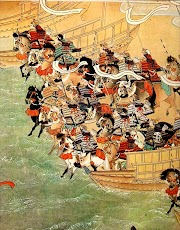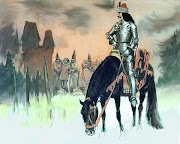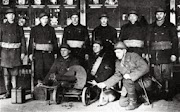Dahlgren Attacks Confederate Homeguards, March 1, 1864
Known to modern historians as the Dahlgren Affair, this failed Union attempt to storm Richmond in order to free Union prisoners of war and to controversially assassinate Confederate President Jefferson Davis and his rebel cabinet would become arguably one of the most controversial moments of the war between the states, 1861-1865. Modern historiographers have recently tied together, with a certain degree of accuracy, the chilling connection between the Dahlgren Affair and the later successful assassination of President Abraham Lincoln by Confederate sympathizer and professional actor John Wilkes Booth in April of 1865 after the wars’ end.
Prelude and Preparations
The Richmond Raid was conceived by Secretary of War Edwin M. Stanton with the direct oversight of President Lincoln. This raid was to have three main objectives, to strike terror into the Confederate civilian populace, to free 5000 Union prisoners of war held at the Libby and Belle Isle prisons, and to distribute thousands of leaflets announcing the “President’s proclamation”, the Emancipation Proclamation of January 1863, the de facto freedom of all African-American slaves held still in Confederate bondage.
Twenty seven year old Brigadier General Hugh J. Kilpatrick, a reckless and fiery cavalry officer who had won quick battlefield promotions from Big Bethel in 1861, to the Second Battle of Bull Run in 1862 and to the Gettysburg Campaign of June-July 1863, was chosen to lead the raid on Richmond. Kilpatrick was and is now commonly referred to as “Kill-Cavalry” for the thousands of men and horses who died under his command throughout the war. Kilpatrick had fought at the Battle of Brandy Station (Battle of Beverly Ford) in June of 1863 and had experience in large scale cavalry raid operations already; having led a cavalry brigade with some success during Stoneman's Raid in April-May 1863 during the Chancellorsville Campaign.
Hugh Judson Kilpatrick, General Kill-Cavalry
The raid faced opposition from both General Meade and the general of the Union cavalry corps, Alfred Pleasonton. Stanton and Lincoln were convinced of the raids potential for greater success and thus allowed the operation to proceed into the planning and preparation stage into late February 1864. Kilpatrick with 3,585 troopers began his grand raid on Richmond fifty miles from the city limits at 11 o’clock at night on February 28. Commanding brigades under Kilpatrick during the raid were the young and glory hungry Brigadier General George A. Custer (b.1839-1876) and the much older and cautious Yankee cavalry officer, Major-General John Sedgwick (b.1813-1864) of Connecticut.
A hand picked detachment of 450 troopers was led by the young Col. Ulric Dahlgren. Their task would be to attack the heart of Richmond to free the POW’s, the young colonel had additional secret objectives that would not be uncovered until after the raid and his own death. Dahlgren had enjoyed a meteoric rise as young officer. The younger son of Rear-Admiral John A. Dahlgren, Ulric was commissioned as an officer on the appointment of Secretary of War Stanton in 1861, serving with distinction under Generals Burnside, Meade, and Hooker.
Col. Ulric Dahlgren
He had fought against JEB Stuart’s rebel cavalry at Brandy Station in 1863 in the largest [mostly] all cavalry battle of the war. Dahlgren was a “cavalier” in the near Southern romantic sense and a victor in several trooper to trooper duels against rebel cavalrymen. His promising career was severely jeopardized following the grave injury and loss of his leg at the Battle of Hagerstown (Williamsport) whilst in command of Company A of the 18th Pennsylvania cavalry under Gen. Kilpatrick.
Young Dahlgren had lost his leg but gained a promotion to colonel-perhaps the youngest in both the Federal and Rebel armies during the war. After recouping aboard his father's warship he was fitted with a prosthetic leg whilst eagerly awaiting another assignment despite his rather serious injury. He received his wish when Kilpatrick accepted his request to join the planned raid on the Confederate capital in mid February 1864. Filled with pride but with an ever so realistic foreboding of the real danger ahead, Col Dahlgren wrote to his father before the raid commenced that it “will be the grandest thing on record; and if it fails, many of us will go up-I may be captured or I may be tumbled over, but it is an undertaking that if I were not in I should be ashamed to show my face again-if we do not return, there is no better place to give up the ghost”.
Dahlgren, standing left, with fellow officers, 1863
Kilpatrick and Custer’s Raids, February 28-29
Kilpatrick’s raid began with his troopers crossing Ely’s Ford on almost a straight march towards the city of Richmond. Major Gen. Sedgewick and his troopers struck out West towards the Rapidan whilst Custer and his 1500 troopers rode further south in an attempt to spread Confederate home guardsmen and Confederate regular army forces thin for a ‘lightning raid’ attack on the capital by Kilpatrick and Dahlgren. Custer ravaged his assigned raiding grounds burning three mills and a few hundred pounds of grain whilst capturing 50 rebels and some 500 southern horses before returning to Union lines on March 1.
The night before Custer’s return, Kilpatrick and his troopers were “knocking at the gates of Richmond” according to author and historian Shelby Foote (b.1916-2005). An icy rainstorm had descended when Kilpatrick and his riders approached the outside defensive works of Richmond. His exhausted troopers had ridden sixty miles in less than thirty-five hours and then were promptly fired upon by the surprisingly precise Confederate homeguard artillery. The firing was so intensive that Kilpatrick was convinced that Confederate regulars had reinforced the Richmond homeguard and soon withdrew to a safer position. This had not been the case necessarily, as Foote points out. In fact it had been the Confederate militia homeguards-old men, young boys, city workers, and government clerks, who manned the guns bravely and with precision until Lee’s reinforcements bolstered their already staunch defense of the capital. These Confederate homeguards numbered around 3,000-5000 lightly armed militia members.
Kilpatrick and his raiders in Virginia, Harpers Weekly, 1864
Waiting in vain for word from Dahlgren, Kilpatrick resumed his raid at 10 o’clock at night by attempting to march down the Mechanicsville Road into the city. This attempt was thwarted by the cavalry corps of Lt. General Wade Hampton who’s troopers nearly succeeded in capturing Kilpatrick himself. The bold Kilpatrick soon realized that he was surrounded in enemy country by both the Confederate militia and regular army troops sent by General Robert E. Lee to reinforce the nearly compromised approaches to Richmond.
Dahlgren’s Ride Febuary 29-March 2nd
Though it had begun with promise, Dahlgren's raid had descended into a quagmire rather quickly. Making fast progress as he had been ordered to do, Dahlgren and his 500 raiders fought freezing rain on their ride into Goochland County. There, Dahlgren used the services of a teenage slave named Martin in order to navigate to his way to Jude’s Ford-from there he would cross the James and enter Richmond from the south. The river was flowing too high and much too rapidly and thus Dahlgren's column was unable to cross. They were most likely harried by Confederate cavalry and most certainly skirmished with scattered bands of rebel homeguards along their route. Outraged by what he perceived as the young slave’s treachery; Col. Dahlgren had him executed (by hanging) and then resumed his roughshod march around the river.
Union 'bluejacket' cavalry armed with Spencer seven shot repeaters, 1864
They skirmished further with bands of rebel militia and Confederate regulars and dozens were shot from their horses or captured as the column successfully forded the river. Dahlgren made it as far as King and Queen Court House on the Mattaponi River by the evening of March 2nd. Riding at the head of his raiders the young colonel was halted by a band of Confederate pickets of the 9th Virginia Cavalry and homeguard militia. Brandishing his revolver he shouted, “Surrender, you damned rebels or ill shoot you!” The confederates answered with a deadly volley and the 22 year old colonel was felled by four musket balls.
Ambuscade and Death of Dahlgren, 1864
His men were soon shot down or made prisoner and perhaps only a handful escaped unscathed. Some were hunted down by bloodhounds and a few may have been killed by the pursuing rebels. Dahlgren’s body was looted; his personal possessions including a watch and his boots were taken as was his artificial leg. Adding to these insults his pinkie finger was cut off by a hapless homeguardsmen who had botched an attempt to loot a small diamond ring from the dead colonel. By the time the Dahlgren papers were discovered Kilpatrick had arrived back to Union lines and was soon fully aware of Col. Dahlgren’s death and the strategic failure of their joint raid.
Kilpatrick had lost 340 troopers killed or missing and 1063 Union horses were lost or too injured to ride again. The general denounced Col. Dahlgren’s death as “murder” but put the full blame of the failure to free the Union POW's on the young colonel alone. Public controversy and outcry would follow in the discovery of the so-called Dahlgren Papers. Though their authenticity remains in question to this day, these unsent orders and letters were addressed to Dahlgren's command and were allegedly found on his bullet ridden body.
These papers according to the Richmond Sentinel on March 5, 1864, detailed the attack on Richmond and supposed assassination plot against President Jefferson Davis and his Confederate cabinet. 'Pioneers' or saboteurs were to be on hand to burn the city and Jefferson's residence in the posh Court End neighborhood of Richmond. Newspapers on both sides of the conflict regurgitated and embellished the accounts of the Dahlgreen orders.
“We will try and secure the bridge to the city, (one mile below Belle Isle,) and release the prisoners at the same time. If we do not succeed they must then dash down, and we will try and carry the bridge from each side. When necessary, the men must be filed through the woods and along the river bank. The bridges once secured, and the prisoners loose and over the river, the bridges will be secured and the city destroyed. The men must keep together and well in hand, and once in the city it must be destroyed and Jeff. Davis and Cabinet killed” [Richmond Sentinel, 5 March, 1864].
Conclusion
Great controversy surrounds the Dahlgren Paper’s today-mainly who authored them and why? Was General Kilpatrick, Col. Dahlgren, another Federal subordinate officer the true author of these? Or were they a Confederate creation for propaganda and moral purposes? Public opinion exploded in the aftermath of the Dahlgren-Kilpatrick Raid, this much can be entirely certain. Southern papers denounced Dahlgren as a terrorist and bandit, calling for swift reprisals and counter raids. Northern papers lionized the young colonel who had died in the service of his country and celebrated the rather minor successes of the raid. Some accounts claimed that he had been executed with a shot to the head and others claimed his body had been publicly displayed as a war prize. Many including Dahlgren’s father sought to prove that the papers were indeed a forgery and that Dahlgren had received no such orders from any senior ranking Union officer.
The major players in the Kilpatrick-Dahlgren Raid met a variety of mixed fates. Kilpatrick was personally blamed by General Meade and the public to an extant for the utter failure of the Richmond Raid. He was exiled from the Eastern Theater of the war, finishing the conflict under the command of Major-General William T. Sherman in the West, including service in the Atlanta Campaign where he was wounded commanding cavalry at the Battle of Resaca (Georgia) in May of 1864. He later fought and was defeated at Lovejoy's Station by the rebel cavalry of Brig. General William H. Jackson.
After the Civil War; Kilpatrick served as ambassador to Chile until 1870. One can imagine that perhaps John Wilkes Booth, who later in 1864 played Marc Anthony in the play Julius Caesar alongside his brothers Edwin and Junius, read with outage the sensational Southern articles such as “Last Ride of the Infernals” by the Richmond Daily Dispatch (March, 1864).
Dahlgren in 1863-1864
It was in 1864 when Booth first made contact with co-conspirators John Surrat, George Azterodt, and Lewis Powell, amongst several others. By 1865 he was ready to act, assassinating Lincoln at Ford’s Theatre on April 15, 1865. Custer finished the war with great distinction, his troopers killed JEB Stuart at Yellow Tavern in 1864 and he was present at Appomattox Courthouse to witness the surrender of General Lee in April of 1865. He served in the Dakotas before meeting his death surrounded by 3000 or more Arapho, Lakota, and Cheyenne warriors at the Battle of the Little Bighorn in June of 1876. Major Gen. John Sedgwick was killed by a rebel sharpshooter at the Battle of Spotsylvania Courthouse in May of 1864, famous for exclaiming to his men, "They couldn't hit an elephant at this distance!", before a rebel bullet found its mark and mortally wounded the old general.
Suggested Further Reading
Shelby Foote The Civil War: A Narrative, Volume II, Chapter III, ‘Spring Came on Forever’ (Random House, 1963-1986).













